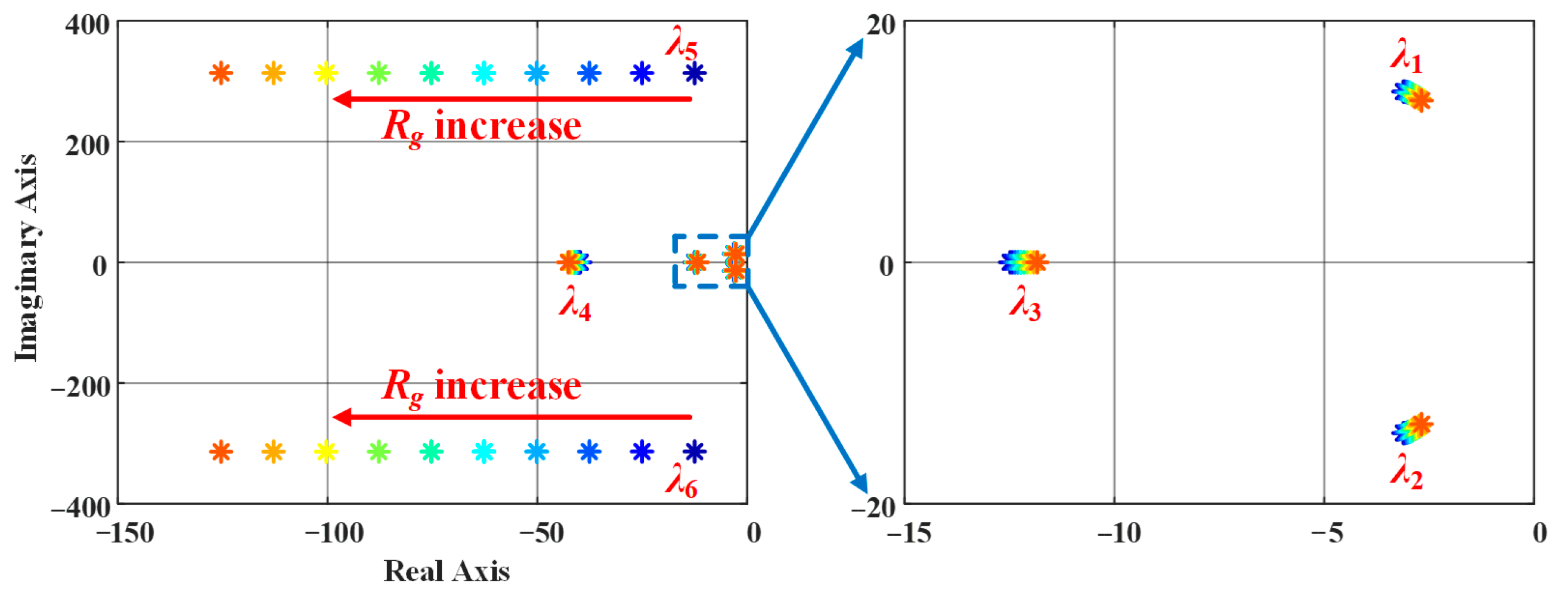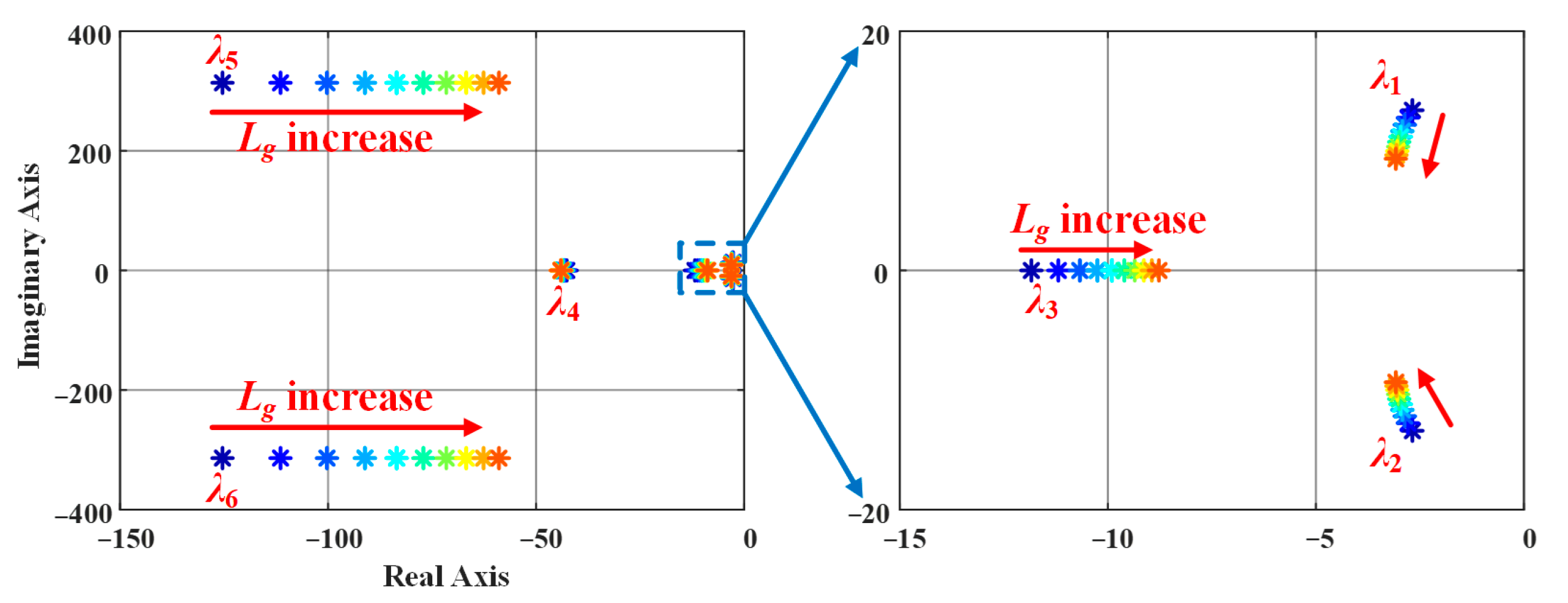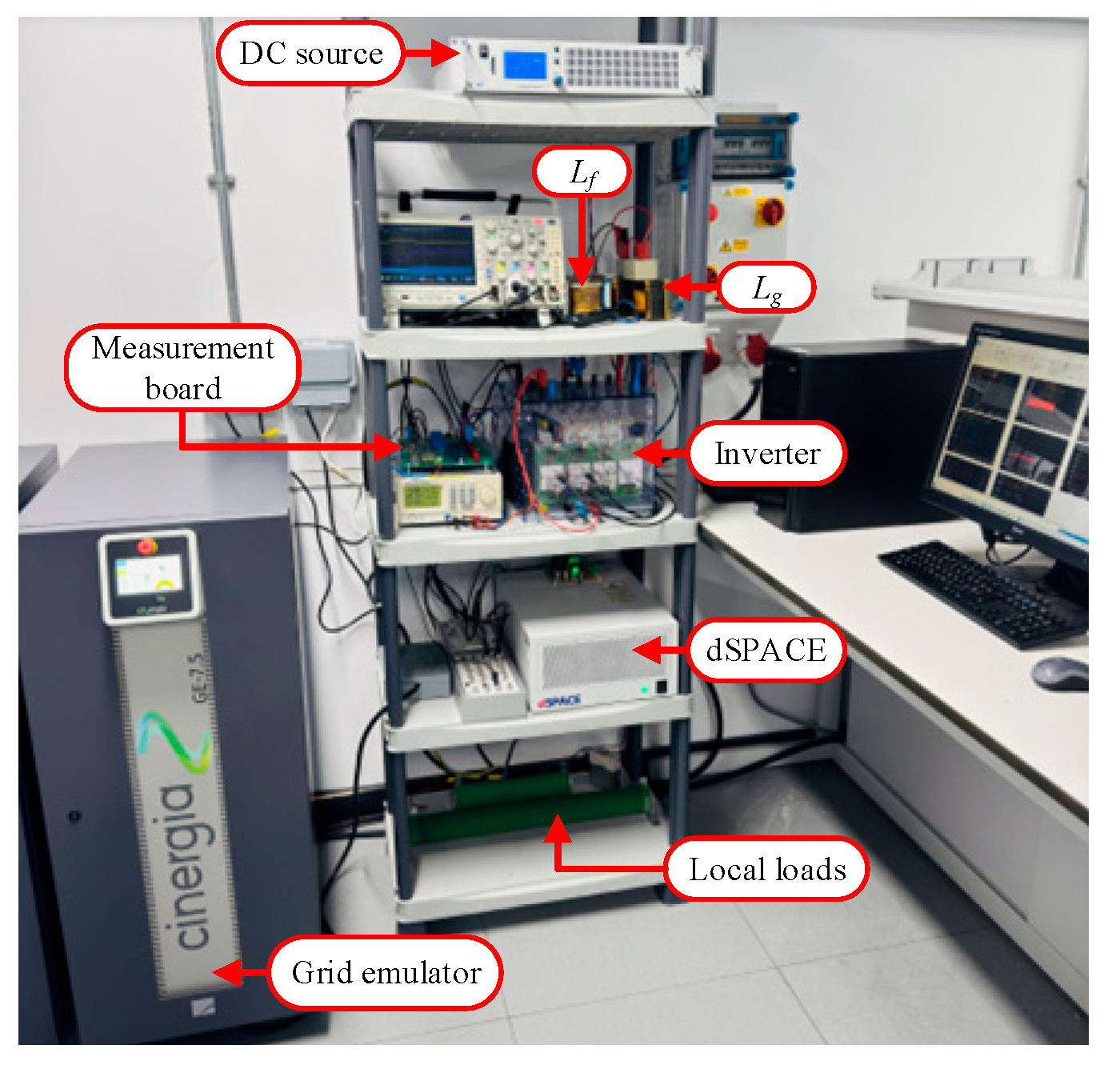Virtual Oscillator Control for Grid-Forming Inverters: Recent Advances, Comparative Evaluation, and Small-Signal Analysis
Abstract
1. Introduction
- (1)
- An overview of recent advancements in various VOC strategies, with a primary focus on the AHO structure, which has gained significant attention for its superior features.
- (2)
- Development of a generalised state-space model to facilitate small-signal analysis of VOCs.
- (3)
- Investigation of the effects of virtual inertia, control parameters, and grid impedance parameters on the transient performance of the AHO, based on the proposed state-space model. This analysis provides practical guidance for control parameter selection in different application scenarios.
- (4)
- Experimental validation of the theoretical findings using extensive tests on a 2.5 kVA single-phase inverter.
2. VOC Structures and Their Ancillary Services
2.1. Dead-Zone Oscillator (DZO)
2.2. Van Der Pol Oscillator (VDPO)
2.3. Andronov–Hopf Oscillator
2.4. Comparison Between Different VOC Strategies
3. Small-Signal Analysis
3.1. State-Space Model
3.2. Effect of Parameters on Transient Performance
4. Experimental Validation
4.1. Test Scenario 1: Providing V2G Service
4.2. Test Scenario 2: Providing V2H Service
4.3. Test Scenario 3: Validation of Small-Signal Analysis
5. Conclusions
Author Contributions
Funding
Data Availability Statement
Conflicts of Interest
References
- Muftau, B.; Fazeli, M. The Role of Virtual Synchronous Machines in Future Power Systems: A Review and Future Trends. Electr. Power Syst. Res. 2022, 206, 107775. [Google Scholar] [CrossRef]
- Suul, J.A.; DArco, S.; Guidi, G. Virtual Synchronous Machine-Based Control of a Single-Phase Bi-Directional Battery Charger for Providing Vehicle-to-Grid Services. IEEE Trans. Ind. Appl. 2016, 52, 3234–3244. [Google Scholar] [CrossRef]
- Rosas, D.S.Y.; Zarate, A. Single-Phase Grid-Forming Strategy with Power Decoupling Implementation for Electrolytic-Capacitor-Free EV Smart Battery Charger. Energies 2023, 16, 894. [Google Scholar] [CrossRef]
- Johnson, B.B.; Dhople, S.V.; Hamadeh, A.O.; Krein, P.T. Synchronization of parallel single-phase inverters with virtual oscillator control. IEEE Trans. Power Electron. 2014, 29, 6124–6138. [Google Scholar] [CrossRef]
- Johnson, B.B.; Sinha, M.; Ainsworth, N.G.; Dorfler, F.; Dhople, S.V. Synthesizing Virtual Oscillators to Control Islanded Inverters. IEEE Trans. Power Electron. 2016, 31, 6002–6015. [Google Scholar] [CrossRef]
- Lu, M.; Dutta, S.; Purba, V.; Dhople, S.; Johnson, B. A Grid-compatible Virtual Oscillator Controller: Analysis and Design. In Proceedings of the 2019 IEEE Energy Conversion Congress and Exposition (ECCE), Baltimore, MD, USA, 29 September–3 October 2019; pp. 2643–2649. [Google Scholar] [CrossRef]
- Lu, M. Virtual Oscillator Grid-Forming Inverters: State of the Art, Modeling, and Stability. IEEE Trans. Power Electron. 2022, 37, 11579–11591. [Google Scholar] [CrossRef]
- Awal, M.A.; Husain, I. Unified Virtual Oscillator Control for Grid-Forming and Grid-Following Converters. IEEE J. Emerg. Sel. Top. Power Electron. 2021, 9, 4573–4586. [Google Scholar] [CrossRef]
- Rezazadeh, H.; Monfared, M.; Fazeli, M.; Golestan, S. Providing Inertial Response with Unified VOC for Single-phase GFM Inverters. In Proceedings of the 2024 International Symposium on Electrical, Electronics and Information Engineering (ISEEIE), Leicester, UK, 26–28 September 2024; pp. 94–98. [Google Scholar] [CrossRef]
- Luo, S.; Chen, W.; Li, X.; Hao, Z. A New Virtual Inertial Strategy for Andronov–Hopf Oscillator Based Grid-Forming Inverters. IEEE J. Emerg. Sel. Top. Power Electron. 2024, 12, 1995–2005. [Google Scholar] [CrossRef]
- Rezazadeh, H.; Monfared, M.; Fazeli, M.; Golestan, S. Enhancing Damping in Single-Phase Grid-Forming Virtual Oscillator Control Inverters: A Feedforward Strategy. IEEE Open J. Ind. Electron. Soc. 2025, 6, 1101–1115. [Google Scholar] [CrossRef]
- Rezazadeh, H.; Monfared, M.; Fazeli, M.; Golestan, S. Voltage-Independent Active-Power Droop Coefficient for Enhanced Andronov–Hopf Oscillator Grid-Forming Inverters. arXiv 2025, arXiv:2511.05252. [Google Scholar]
- Aghdam, S.A.; Agamy, M. Virtual oscillator-based methods for grid-forming inverter control: A review. IET Renew. Power Gener. 2022, 16, 835–855. [Google Scholar] [CrossRef]
- Lu, M.; Dhople, S.; Johnson, B. Benchmarking Nonlinear Oscillators for Grid-Forming Inverter Control. IEEE Trans. Power Electron. 2022, 37, 10250–10266. [Google Scholar] [CrossRef]
- Rezazadeh, H.; Monfared, M.; Fazeli, M.; Golestan, S. Single-phase Grid-forming Inverters: A Review. In Proceedings of the 2023 International Conference on Computing, Electronics & Communications Engineering (iCCECE), Swansea, UK, 14–16 August 2023; pp. 7–10. [Google Scholar] [CrossRef]
- Lu, M.; Purba, V.; Dhople, S.; Johnson, B. Comparison of Droop Control and Virtual Oscillator Control Realized by Andronov-Hopf Dynamics. IECON Proc. (Ind. Electron. Conf.) 2020, 2020, 4051–4056. [Google Scholar] [CrossRef]
- Rezazadeh, H.; Monfared, M.; Fazeli, M.; Golestan, S. Virtual Oscillator Control for Grid-forming Inverters: An Overview of Recent Developments and Small-Signal Analysis. ECCE 2025, in press.
- Johnson, B.B.; Dhople, S.V.; Cale, J.L.; Hamadeh, A.O.; Krein, P.T. Oscillator-Based Inverter Control for Islanded Three-Phase Microgrids. IEEE J. Photovolt. 2014, 4, 387–395. [Google Scholar] [CrossRef]
- Leyba, E.R.M.; Opila, D.F.; Kintzley, C.K. Three Phase Dead-Zone Oscillator Control Under Unbalanced Load Conditions. In Proceedings of the 2019 IEEE Electric Ship Technologies Symposium (ESTS), Washington, DC, USA, 14–16 August 2019; pp. 134–140. [Google Scholar] [CrossRef]
- Sinha, M.; Dhople, S.; Johnson, B.; Ainsworth, N.; Dorfler, F. Nonlinear supersets to droop control. In Proceedings of the 2015 IEEE 16th Workshop on Control and Modeling for Power Electronics (COMPEL), Vancouver, BC, Canada, 12–15 July 2015; pp. 1–6. [Google Scholar] [CrossRef]
- Raisz, D.; Thai, T.T.; Monti, A. Power Control of Virtual Oscillator Controlled Inverters in Grid-Connected Mode. IEEE Trans. Power Electron. 2019, 34, 5916–5926. [Google Scholar] [CrossRef]
- Awal, M.A.; Yu, H.; Tu, H.; Lukic, S.M.; Husain, I. Hierarchical Control for Virtual Oscillator Based Grid-Connected and Islanded Microgrids. IEEE Trans. Power Electron. 2020, 35, 988–1001. [Google Scholar] [CrossRef]
- Awal, M.A.; Yu, H.; Husain, I.; Yu, W.; Lukic, S.M. Selective Harmonic Current Rejection for Virtual Oscillator Controlled Grid-Forming Voltage Source Converters. IEEE Trans Power Electron. 2020, 35, 8805–8818. [Google Scholar] [CrossRef]
- Awal, M.A.; Rachi, M.R.K.; Yu, H.; Husain, I.; Lukic, S. Double Synchronous Unified Virtual Oscillator Control for Asymmetrical Fault Ride-Through in Grid-Forming Voltage Source Converters. IEEE Trans. Power Electron. 2023, 38, 6759–6763. [Google Scholar] [CrossRef]
- Costa, D.A.; Tôrres, L.A.B.; Silva, S.M.; De Conti, A.; Brandão, D.I. Parameter Selection for the Virtual Oscillator Control Applied to Microgrids. Energies 2021, 14, 1818. [Google Scholar] [CrossRef]
- Shi, Z.; Li, J.; Nurdin, H.I.; Fletcher, J.E. Comparison of Virtual Oscillator and Droop Controlled Islanded Three-Phase Microgrids. IEEE Trans. Energy Convers. 2019, 34, 1769–1780. [Google Scholar] [CrossRef]
- Li, J.; Fletcher, J.E.; Holmes, D.G.; McGrath, B.P. Developing a machine equivalent inertial response for a Virtual Oscillator Controlled Inverter in a machine-inverter based microgrid. In Proceedings of the 2020 IEEE Energy Conversion Congress and Exposition (ECCE), Detroit, MI, USA, 11–15 October 2020; pp. 4314–4321. [Google Scholar] [CrossRef]
- Aghdam, S.A.; Agamy, M. Adaptive Virtual Inertia Synthesis via Enhanced Dispatchable Virtual Oscillator Controlled Grid-Tied Inverters. In Proceedings of the IECON 2021—47th Annual Conference of the IEEE Industrial Electronics Society, Toronto, ON, Canada, 13–16 October 2021; pp. 1–6. [Google Scholar] [CrossRef]
- Inverters, G. A Nonlinear MPC-Based Adaptive Inertia Strategy for Andronov-Hopf Oscillator Controlled. In Proceedings of the IEEE Energy Conversion Congress and Exposition, Phoenix, AZ, USA, 20–24 October 2024; pp. 1506–1511. [Google Scholar] [CrossRef]
- Awal, M.A.; Husain, I. Transient Stability Assessment for Current-Constrained and Current-Unconstrained Fault Ride through in Virtual Oscillator-Controlled Converters. IEEE J. Emerg. Sel. Top. Power Electron. 2021, 9, 6935–6946. [Google Scholar] [CrossRef]
- Yu, H.; Awal, M.A.; Tu, H.; Husain, I.; Lukic, S. Comparative Transient Stability Assessment of Droop and Dispatchable Virtual Oscillator Controlled Grid-Connected Inverters. IEEE Trans. Power Electron. 2021, 36, 2119–2130. [Google Scholar] [CrossRef]
- Luo, S.; Chen, W.; Hao, Z.; Wang, Y. A Transient Stability Enhanced Andronov-Hopf Oscillator for Grid-Forming Converters. IEEE Trans. Power Electron. 2024, 39, 10853–10864. [Google Scholar] [CrossRef]
- Li, L.; Song, H.; Wang, S.; Liu, M.; Gao, S.; Li, H. Transient Stability Analysis and Enhanced Control Strategy for Andronov-Hopf Oscillator Based Inverters. IEEE Trans. Energy Convers. 2025, 40, 995–1008. [Google Scholar] [CrossRef]
- Lu, M. An Inrush Current Limiting Strategy for Virtual-Oscillator-Controlled Grid-Forming Inverters. IEEE Trans. Energy Convers. 2023, 38, 1501–1510. [Google Scholar] [CrossRef]
- Gurugubelli, V.; Ghosh, A.; Panda, A.K. Improved Hopf Oscillator-Based VOC Method for Fast Synchronization of Parallel Inverters in Standalone Microgrid. IEEE J. Emerg. Sel. Top. Power Electron. 2024, 12, 3018–3025. [Google Scholar] [CrossRef]
- Tran, T.T.; Gurumurthy, S.K.; Tran, M.-Q.; Nguyen-Huu, T.-A.; Heins, T.; Ponci, F.; Monti, A.; Nguyen, P.H. Enhancing Performance of Andronov-Hopf Oscillator-Based Grid-Forming Converters in Microgrids with Non-Invasive Online Impedance Estimation. IEEE Trans. Smart Grid 2023, 14, 4479–4493. [Google Scholar] [CrossRef]
- Zeng, Z.; Fan, J.; Sun, Y.; Wang, S.; Yang, D. A Dispatchable Virtual Oscillator Controller in the dq Frame with Enhanced Grid-Forming Power Reference Tracking Capability. IEEE Trans. Power Electron. 2025, 40, 10973–10987. [Google Scholar] [CrossRef]
- Task Force C6.04.02. In Benchmark Systems for Network Integration of Renewable and Distributed Energy Resources; Brochure No. 575; CIGRE: Paris, France, 2014; ISBN 978-2-85873-270-8.
- Guerrero, J.M.; Vasquez, J.C.; Matas, J.; de Vicuna, L.G.; Castilla, M. Hierarchical Control of Droop-Controlled AC and DC Microgrids—A General Approach Toward Standardization. IEEE Trans. Ind. Electron. 2011, 58, 158–172. [Google Scholar] [CrossRef]

















| VOC | DZO | VDPO | AHO | ||||||
|---|---|---|---|---|---|---|---|---|---|
| [4,18,19,25] | [5] | [21,22,23] | [6] | [8] | [9,10] | [11] | [12] | ||
| Droop | mp | ||||||||
| mq | |||||||||
| Dispatchability | ✕ | ✕ | ✓ | ✓ | ✓ | ✓ | ✓ | ✓ | |
| FRT | ✕ | ✕ | ✕ | ✕ | ✓ | ✕ | ✕ | ✕ | |
| Virtual inertia | ✕ | ✕ | ✕ | ✕ | ✕ | ✓ | ✓ | ✕ | |
| Damping | ✕ | ✕ | ✕ | ✕ | ✕ | ✕ | ✓ | ✕ | |
| Voltage-independent APL droop | ✕ | ✕ | ✕ | ✕ | ✕ | ✕ | ✕ | ✓ | |
| VOC | VDPO [5] | AHO [6] | uVOC [8] |
|---|---|---|---|
| f1 (V) | |||
| f2 (V, Q) | |||
| f3 (V, P) |
| Parameters | Description | Value |
|---|---|---|
| P0, Q0 | Rated active and reactive power | 2000 W, 1500 var |
| Vdc | DC-link voltage | 380 V |
| ꞷ0 | Nominal angular frequency | 2π × 50 rad/s |
| Vp0 | Nominal voltage amplitude | 311 V |
| fs | Switching frequency | 20 kHz |
| Lf, Rf, Cf | Filter parameters | 7 mH, 0.08 Ω, 3.9 μF |
| Lg, Rg | Grid parameters | 1 mH, 1 Ω |
| µ, Ki | AHO control parameters | 2.38 × 10−4, 83.82 |
| Tf | Virtual inertia control parameter | 1/(2π) |
| Tf | ξ | ꞷn (rad/s) | OS (%) | trise (ms) |
|---|---|---|---|---|
| 1/(6π) | 0.34 | 23.84 | 32 | 75 |
| 1/(2π) | 0.20 | 13.66 | 53 | 131 |
| Case | OS % | trise (ms) | ||
|---|---|---|---|---|
| Theoretical | Experimental | Theoretical | Experimental | |
| Baseline Case | 53 | 43 | 131 | 130 |
| Tf = 1/(6π) s | 32 | 23 | 75 | 75 |
| Rg = 0.1 Ω | 50 | 41 | 124 | 120 |
| Lg = 10 mH | 35 | 27 | 183 | 175 |
| Lf = 10 mH | 45 | 33 | 150 | 160 |
| Ki = 2Ki,set | 70 | 60 | 93 | 85 |
| μ = 2μset | 51 | 41 | 131 | 130 |
Disclaimer/Publisher’s Note: The statements, opinions and data contained in all publications are solely those of the individual author(s) and contributor(s) and not of MDPI and/or the editor(s). MDPI and/or the editor(s) disclaim responsibility for any injury to people or property resulting from any ideas, methods, instructions or products referred to in the content. |
© 2025 by the authors. Licensee MDPI, Basel, Switzerland. This article is an open access article distributed under the terms and conditions of the Creative Commons Attribution (CC BY) license (https://creativecommons.org/licenses/by/4.0/).
Share and Cite
Rezazadeh, H.; Monfared, M.; Fazeli, M.; Golestan, S. Virtual Oscillator Control for Grid-Forming Inverters: Recent Advances, Comparative Evaluation, and Small-Signal Analysis. Energies 2025, 18, 5981. https://doi.org/10.3390/en18225981
Rezazadeh H, Monfared M, Fazeli M, Golestan S. Virtual Oscillator Control for Grid-Forming Inverters: Recent Advances, Comparative Evaluation, and Small-Signal Analysis. Energies. 2025; 18(22):5981. https://doi.org/10.3390/en18225981
Chicago/Turabian StyleRezazadeh, Hamed, Mohammad Monfared, Meghdad Fazeli, and Saeed Golestan. 2025. "Virtual Oscillator Control for Grid-Forming Inverters: Recent Advances, Comparative Evaluation, and Small-Signal Analysis" Energies 18, no. 22: 5981. https://doi.org/10.3390/en18225981
APA StyleRezazadeh, H., Monfared, M., Fazeli, M., & Golestan, S. (2025). Virtual Oscillator Control for Grid-Forming Inverters: Recent Advances, Comparative Evaluation, and Small-Signal Analysis. Energies, 18(22), 5981. https://doi.org/10.3390/en18225981








